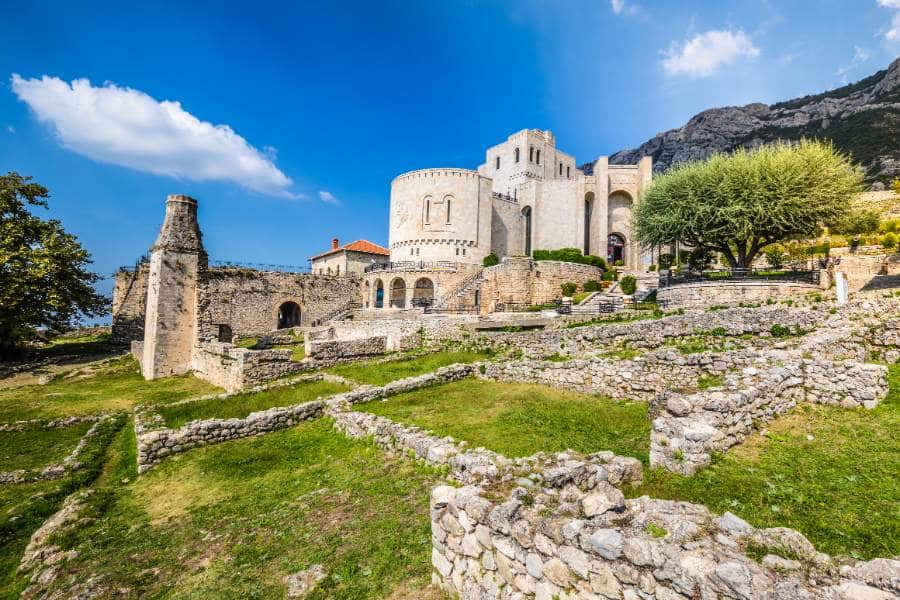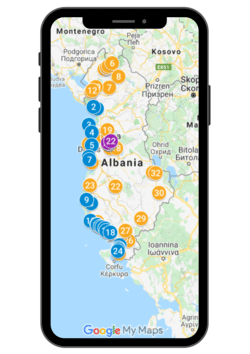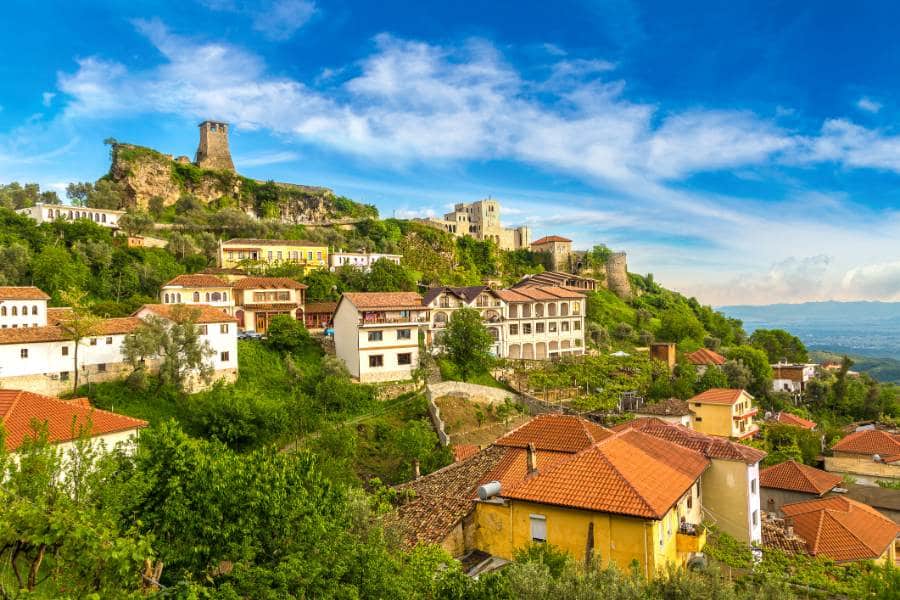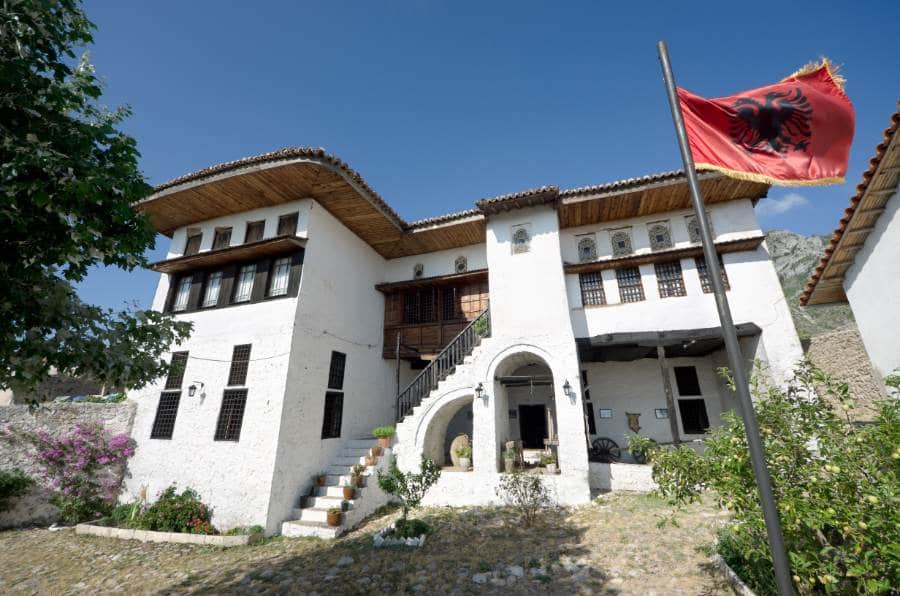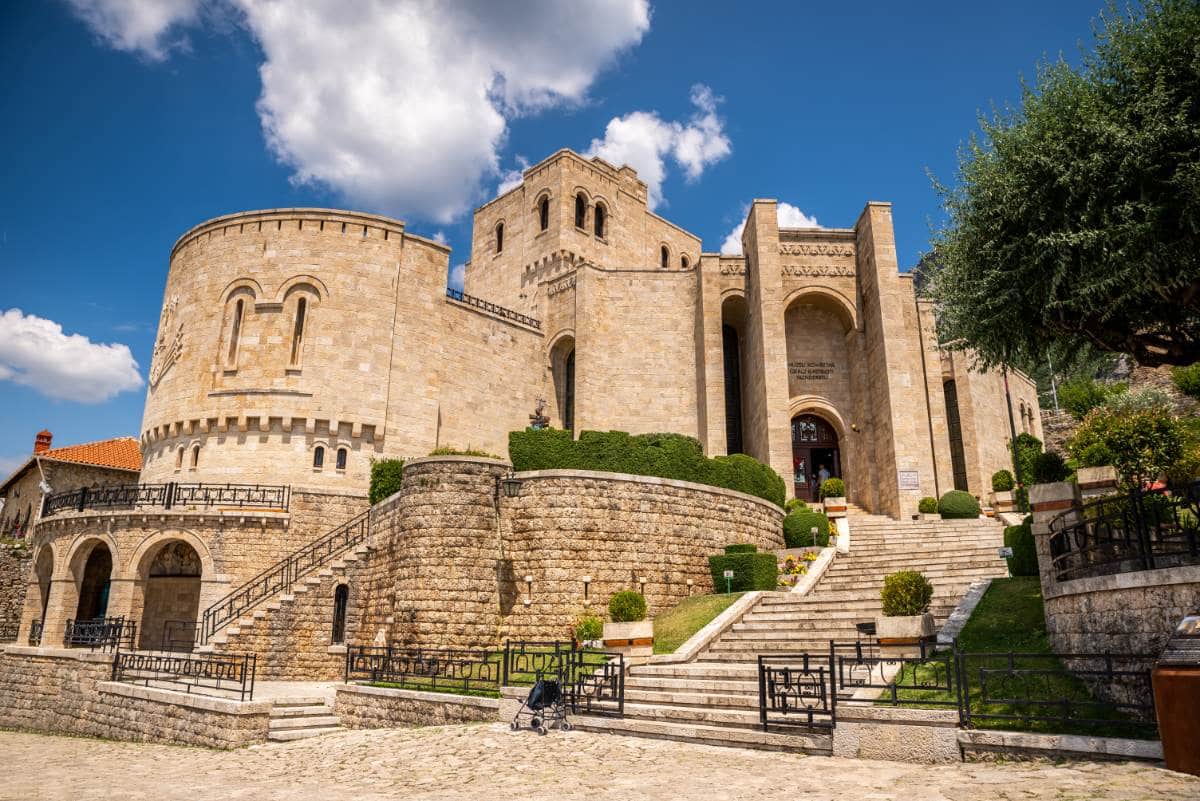
Is Kruja worth visiting?
If you are travelling to Albania, you might be wondering if Kruja is worth visiting? Especially, since Kruja is so close to the capital city Tirana, so Kruja is an easy place to visit.
Is Kruja worth visiting? Kruja is definitely worth visiting. Kruja is one of the most famous towns in Albania, as it was the home of Albania’s national hero Skanderbeg. Kruja is one of the top sightseeing places in Albania. Kruja is certainly worth a 1-day visit.
If you are planning to visit Kruja during your holiday, I will give you all the details you need to plan a trip to Kruja. I will discuss the spots worth visiting in Kruja, the best things to do and how to get to Kruja from Tirana or Durres.
Why is Kruja worth visiting?
Kruja is worth visiting. Kruja is one of the top sightseeing locations in Albania. The main attraction is the Kruja Castle. The Kruja Castle is a hilltop castle with a stunning panoramic view.
As a private tour guide in Albania, I recommend you go on a 1-day trip to Kruja. Once you arrive in Kruja, you will need 3-4 hours to visit the main sights.
A visit to Kruja starts with walking through the Kruja Castle and admiring the stunning panoramic views. Then, you can explore the Skanderbeg Museum and the Ethnographic Museum, which are located inside the castle’s walls. Afterwards, you can explore the Old Bazaar Market on the slope of the hill. The market is a great place to shop for souvenirs, handicrafts, enjoy a coffee on the terrace or grap a bite to eat.
The Castle of Kruja used to belong to Albania’s national hero Skanderbeg. In this blog post, I will introduce you to Albania’s national hero and discuss the best places to visit in Kruja.
Kruja & Albania’s national hero Skanderbeg
In Albania, Kruja is a famous place, because it was the hometown of Albania’s national hero Skanderbeg. Although Skanderbeg died in 1468, he is still a greatly admired hero for the Albanian people. For instance, the central square in Tirana is called “Skanderbeg Square” and still has a very prominent statue of Skanderbeg on his horse.
Skanderbeg was a very strong military commander. He became Albania’s national hero because he was a leader who defended the Albanians against the invasion of the Ottoman Turkish Empire.
If you look at Albania’s history, Albania was not an independent country for a very long time. Basically, Albania was a part of the Greek Empire, then the Roman Empire, then the Byzantine Empire and then the Ottoman Empire. Essentially, the Albanians were always ruled by another country or empire.
Skanderbeg became the national hero of the Albanian people because he united the different Albanian tribes. He was the leader who fought against the Ottoman Turks, who were invading Albania. Due to his strong military skills, Skanderbeg was able to successfully keep the Ottomans from invading Albania for 25 years from 1443 to 1466.
Skanderbeg is seen as the defender of the Albanian people. The leader who stood up and brought the Albanians together. And he is also greatly admired for his military skills and strategic thinking.
The truth is that after Skanderbeg died, Albania still became a part of the Ottoman Empire, because the Albanians had lost their strong military commander. But the Albanian people admire Skanderbeg for his 25 years of success in defending their country.
The Castle of Kruja
In Kruja, you can visit the castle of Skanderbeg. Although the castle is mostly in ruins, it has a very impressive panoramic view of the entire valley. You may find pictures online of Kruja, but this is a view that a picture can never do justice! You have to see this amazing view from Kruja with your own eyes.
Inside the castle of Kruja, you can visit two museums: The Skanderbeg Museum and the Ethnographic Museum. As a tour guide in Albania, I highly recommend you visit both museums because they are both beautiful and give you a unique insight into the Albanian culture and lifestyle.
The Skanderbeg Museum
The Skanderbeg Museum is located inside the Castle of Kruje. It is a museum about Albania’s national hero Skanderbeg. But it offers much more than that! Actually, the Skanderbeg Museum gives you a great overview of Albania’s history.
The Skanderbeg Museum is a very grant museum, shaped like a fortress. Although it looks like a historic museum, it was actually built and opened in 1982. Basically, the Kruja Castle is old and dates back to the 5th or 6th century AD, but the Skanderbeg Museum inside the castle is quite new.
The Skanderbeg Museum starts will a small collection of archaeological finds from prehistoric Albania. Then, it shows you beautiful maps of the Albanian castles. It shows you how the Turkish Ottoman Empire invaded the Balkan Peninsula, one city at the time or rather one battle at the time.
There are beautiful murals that display Skanderbeg’s story and that of Albania. One mural shows how Skanderbeg returned to his hometown Kruja. Another mural shows how Skanderbeg brought the tribal leaders together and united them in a fight against the Ottoman invasion.
When you walk through the museum, you must remember that it was built during the communist period in Albania. In fact, the museum was designed by the daughter of the communist dictator. So the museum certainly has communist undertones. And of course, displaying Skanderbeg as the national hero was in line with the communist’s nationalistic agenda for sure.
But it is a very impressive museum nonetheless. And certainly worth a visit for about 45 minutes.
The Ethnographic Museum of Kruja
The Ethnographic Museum of Kruja is definitely worth a visit. This museum is actually a traditional family home from 1764. The family home was converted into a museum.
The home used to belong to the rich Toptani family. Walking through the traditional home gives you a unique insight into the Albanian lifestyle. It shows you what life was like for a rich family during Ottoman rule.
The museum has a large collection of home and food making tools on the ground floor. You will see that the family was incredibly self-sufficient. As they could make their own olive oil, wine, raki, wicker baskets, iron tools and food.
The first floor of the house shows the living quarters of the family. It has a beautiful display of Albanian traditional clothing and homemaking. Although this museum shows you a house from 1764, many of the traditions shown in the house are still in use today in Albania. As a westerner, you might be surprised how traditional, homemade and perhaps old-fashioned the Albanian lifestyle still is today.
The Old Bazaar Market of Kruja
The Old Bazaar Market is one of the highlights of a visit to Kruja. The Old Bazaar Market is located on the slope of the hill. So when you arrive in Kruje by car or bus, you will walk through the market on your way to the Castle of Kruja.
The Old Bazaar Market is a 500-year-old marketplace, which dates back to the period that Albania was ruled by the Turkish Ottoman Empire. The market has a beautiful selection of souvenirs, antique items and handicrafts.
On the Old Bazaar Market, you can buy beautiful handwoven fabrics and carpets. There is a great selection of traditional Albanian clothing. You can also browse antiques, like old lamps, iron supplies and paintings. There are wooden handicraft items, like wooden spoons and cutting boards. And of course, Albania souvenirs like wallets, pens, mugs and hats.
Apart from the shops, there are also beautiful cafes with terraces alongside the marketplace. So it is a great place to enjoy a coffee and relax after you visit the Castle of Kruja and its museums.
How to get from Tirana to Kruja?
You can get from Tirana to Kruje by bus, by car or by taxi. There is no train connection between Tirana and Kruja.
Tirana to Kruja by bus
The bus from Tirana to Kruja costs 150 Leke (1.25 euros) per person for a one-way journey. By bus, it will take you 56 minutes to get from Tirana to Kruja. However, you will need extra time to travel from Tirana’s city centre to the Regional Bus Terminal, where the bus to Kruja departs.
If you want to take the bus from Tirana to Kruja, you must first travel to the Regional Bus Terminal. The Regional Bus Terminal is about a 15-20 minute drive from the city centre of Tirana. You can take a short taxi ride or get on the city bus.
The city bus from Tirana’s city centre to the Regional Bus Terminal departs close to Skanderbeg Square, which is the central square of Tirana. If you are standing on Skanderbeg Square, you need to walk to the backside of the National History Museum.
The bus to the Regional Bus Terminal departs from the Dede Gjo Luli Street (In Albanian: Rruga Dede Gjo Luli) on the back of the National History Museum.
From the bus station on Dede Gjo Luli Street (In Albanian: Rruga Dede Gjo Luli), you must take the bus to Instituti Bujqesor. The bus to Instituti Bujqesor makes a stop at the Regional Bus Terminal North and South Albania. A bus ticket will cost you less than 1 euro, so take some Albanian Leke coins with you.
Tirana to Kruja by taxi
A taxi from Tirana to Kruje costs between 25 euros and 30 euros. I have recently contacted all the popular taxi companies in Albania and asked for their price list, so here are the taxi prices by company:
- Merr Taxi charges 30 euros for a taxi from Tirana to Kruje
- UPs Taxi charges 3081 ALL (25.50 euros) for a taxi from Tirana to Kruje
- Speedtaxi charges 3000 Leke or 25 euros for a taxi from Tirana to Kruje
- City Taxi charges 3000 Leke (25 euros) for a taxi from Tirana to Kruje
- Euro Taxi charges 30 euros for a taxi from Tirana to Kruje
By taxi, it will take you 45-60 minutes to travel from Tirana’s city centre to Kruje. The speed of your journey really depends on the amount of traffic in Tirana’s city centre, which can be full of cars depending on the time of day.
Tirana to Kruja by rental car
You can get from Tirana to Kruje by rental car. A rental car in Albania costs at least 20-25 euros per day in Albania. For your trip from Tirana to Kruje and back you will need approximately 3000 Leke (25 euros) worth of petrol.
I have recently contacted all the car rental companies in Albania and compared their pricing. You can find the cheapest car rental companies in my blog post here: https://albaniatourguide.com/how-much-does-it-cost-to-rent-a-car-in-albania/
From Tirana’s city centre, you can take the highway in the direction of Durres (SH2). Get off the highway at Vore. From Vore, the SH52 leads through Fushe-Kruje and then to Kruje. Fushe-Kruje is basically the village at the bottom of the hill. Fushe-Kruje means “lower Kruje”. However, the sightseeing spots of Kruje are in the Kruje village on the top of the hill.
If you are going to drive in Albania, you must be a confident, experienced and alert driver. Because driving in Albania can be challenging and daunting as a foreigner. The Albanian drivers have a chaotic, unorganized and aggressive driving style. And unfortunately, not all Albanian drivers care to follow the rules of the road.
How to get from Tirana airport to Kruja?
You can get from Tirana airport to Kruja by taxi or by rental car. Unfortunately, there is no direct bus from Tirana airport to Kruja.
If you plan on taking a taxi from Tirana airport to Kruja, it will cost you 22 euros. Tirana airport has officially licenced taxis, which are parked in front of the Arrivals Hall at Tirana airport. These licenced taxis operate with a set price list, so they will all charge you 22 euros.
If you plan on hiring a rental car to get from Tirana airport to Kruja, you can read my advice about renting a car in the previous paragraph.
To be honest, travelling from Tirana airport to Kruja by bus is not really a good option. To start, there is no direct bus from Tirana airport to Kruja. So you would need to take the bus from the Regional Bus Terminal outside Tirana.
As there is no bus from Tirana airport to the Regional Bus Terminal, you would need to take a taxi to the Regional Bus Terminal to then get on the bus. This is possible, but really you would save only a little money and it would take a lot more time.
Best things to do in Kruja
The best things to do in Kruja are:
1) Visit the Kruje Castle
2) Visit the Skanderbeg Museum
3) Visit the Ethnographic Museum of Kruja
4) Visit the Old Bazaar Market
5) Visit the Cave of Sarisalltik
Kruje Castle
The castle of Kruje is an impressive hillside castle, which is located above the city of Kruje. The castle has breathtaking views of the surrounding area and Tirana city in the distance.
The small medieval castle is famous in Albania because it was the headquarters of the national hero Skanderbeg.
In the 15th century, the powerful Turkish Ottoman empire was conquering the Balkans. However, the Ottoman Turks were not able to break the defences of the Kruje Castle. The rebellion against the Ottomans was led by Albania’s national hero Skanderbeg. He had serious military skills, and therefore, he was compared to Alexander the Great.
Skanderbeg Museum
The Skanderbeg Museum is one of the most visited & most important museums in Albania. It is named after Skanderbeg, who is Albania’s national hero. Skanderbeg was a warrior and battle commander. He reunited the different Albanian families and tribes. And he created an army that fought against the Ottoman Turks for 25 years.
In the museum, you can experience the story of Skanderbeg’s life and military battles in chronological order. You get to know the story of Albania’s most celebrated national hero!
Ethnographic Museum of Kruja
The Ethnographic Museum of Kruja is a traditional home, where you can get a unique, insight into the traditional Albanian household customs. The house was originally built in the 19th century by the affluent Toptani family. Inside the museum, you will see how self-sufficient the family was. The family produced its own food, honey, leather, weapons and olive oil. It even has a mini hammam and a little watermill. The house’s wall displays beautiful fresco paintings.
Old Bazaar Market
The Old Bazaar is one of the oldest Ottoman-style markets in Albania. The marketplace was built over 400 years ago and it was recently restored in 2015.
In the bazaar, you can buy souvenirs and traditional handicraft items from Albania. Popular products in the market are traditional Albanian clothing, rugs, copper pots, silver jewellery and embroidered tablecloths. It is a lovely market to stroll around or you can enjoy a coffee at one of the cafes along the street.
The Cave of Sarisalltik
The mountain cave of Sarisalltik is a religious location in Albania. Pilgrims hike up to the cave because the journey has a sacred meaning for them.
The cave of Sarisalltik is at a height of 1176 meters and it has the most amazing view of the surrounding landscape. Inside the cave, you can visit the fountain of holy water, the first Albanian mosque and the grave of Sarisalltik, who was a religious leader.
What is Kruje Albania known for?
Kruje in Albania is known for the Kruje Castle, which used to belong to Albania’s national hero Skanderbeg.
As a tourist in Kruje, you can visit the impressive Kruje Castle. The castle of Kruje is located on a hilltop at 608 meters above sea level. Therefore, the hilltop castle has a stunning panoramic view of the entire valley, Tirana city and the Adriatic Sea in the distance.
In Albania, the Castle of Kruje is well known, because it was the hometown of Skanderbeg. Skanderbeg was a military commander and leader, who defended Albania when the Ottoman Turks were invading the country. Skanderbeg united the different Albanian tribes and noblemen and was their leader in the defence against the Ottoman Empire.
Because Skanderbeg possessed very strong military skills, he was able to win battle after battle for a period of 25 years until his death. For this reason, Skanderbeg has become an icon for the Albanian people. For the Albanians, Skanderbeg represents a hero, who was proud of being an Albanian.
How old is Kruja Albania?
Kruja castle dates back to the 5th or 6th century. The castle’s walls are mostly in ruins, but are still a popular tourist attraction to visit today. Although the castle dates back to the 5th or 6th century, it only became famous in 1443, when Skanderbeg returned to his hometown and reclaimed the castle of Kruja. From 1444 – 1466, Skanderbeg used Kruje castle as his base to defend the Albanian people against the Ottoman Turks.
That said, the area around Kruja has been inhabited since prehistoric times. Inside the Skanderbeg Museum in Kruja Castle, you can see archaeological objects that were found near the Kruja in the Zgerdec village. The village used to be called “Albanopolis”, which was the capital of the Illyrian Empire.
How old is the castle of Kruja?
The castle of Kruja was built in the 5th or 6th century AD. You can still see the outer defence walls of the castle of Kruja today. Although the castle of Kruja dates back to the 5th or 6th century, the museums inside the castle are much newer.
Where to stay in Kruja?
If you would like to stay in Kruje, I highly recommend booking Hotel Panorama. This impressive hotel is located right next to the Old Bazaar Market in Kruja. The Panorama Hotel is incredibly close to the Kruja Castle and therefore offers a fantastic panoramic view. From the hotel’s entrance, it only takes you 10 seconds to walk to the Old Bazaar Market and about 2 minutes to reach the castle of Kruja.
That said, Kruja is a popular day tour destination for tourists staying in Tirana. Kruja is only a 45-60 minute drive from the capital city, so a very easy destination to visit from Tirana.

About me
I am an Albania Tour Guide, who organizes 1-day, 2-day or multiple day private tours in Albania. I arrange your transportation and I am your English speaking guide. So that, you get to experience the most beautiful places in Albania!
Kind regards, Manon

Welcome to Albania!
I am a Tour Guide in Albania
I am an Albania Tour Guide, who organizes 1-day, 2-day or multiple day private tours in Albania.
Book your free Albania Planning Session via Skype now, by using my online scheduler to find a time that’s convenient for you.


